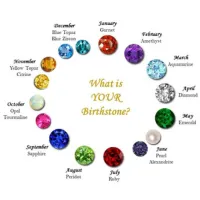Birthstones have long been a popular method to commemorate a person’s birthday by associating it with a gemstone that is thought to have some kind of magical or symbolic significance. Modern and traditional birthstones now signify distinct months, reflecting how these relationships have developed throughout time. Learn more about the cultural importance of birthstones, where they came from, and how birthstone lists came to be below.
Development of Modern Birthstone Lists

In 1912, the American National Retail Jewelers Association—now called Jewelers of America—officially established the contemporary birthstone list. New gem finds, cultural preferences, and accessibility all led to further updates to this list. Birthstones nowadays are more about aesthetics and functionality than their ancient counterparts, which means you can get them in a rainbow of colors and at a reasonable price.
Symbolic, curative, or protecting powers were ascribed to several traditional birthstones in bygone cultures. Contrarily, the contemporary birthstones represent gemstones that gained popularity or accessibility relatively recently as a result of mining and commerce advancements.
Origins, Mines, and Discovery
Ancestral birthstones may be traced back to ancient cultures like Egypt, where stones like garnet were interred in graves, and the middle Ages, when jewels were thought to possess curative powers. The Greeks used amethyst (February) to stave off intoxication, while Cleopatra famously treasured emerald (May), a stone representing rebirth.
| Month | Traditional Birthstone | Modern Birthstone | Color(s) | Origins & Discovery |
| January | Garnet | Garnet | Red | Ancient Egypt, India |
| February | Amethyst | Amethyst | Purple | Ancient Greece, Uruguay |
| March | Bloodstone | Aquamarine | Blue | Brazil, Madagascar |
| April | Diamond | Diamond | Clear, Blue, Pink | India, Brazil, South Africa |
| May | Emerald | Emerald | Green | Colombia, Zambia, Afghanistan |
| June | Pearl, Moonstone | Alexandrite, Pearl | White, Green, Red | Japan (Pearl), Russia (Alexandrite) |
| July | Ruby | Ruby | Red | Burma, Mozambique |
| August | Sardonyx | Peridot | Green | Egypt, China |
| September | Sapphire | Sapphire | Blue | Sri Lanka, India, Myanmar |
| October | Opal, Tourmaline | Opal, Tourmaline | Multi-color | Australia (Opal), Brazil (Tourmaline) |
| November | Topaz, Citrine | Topaz, Citrine | Yellow, Blue | Brazil (Topaz), Spain (Citrine) |
| December | Turquoise, Lapis Lazuli | Tanzanite, Blue Zircon | Blue, Violet | Tanzania (Tanzanite), Cambodia (Zircon) |
Historical and Modern Perspectives

Traditional Birthstones
Birthstones nowadays are more marketed and represent fresh discoveries. One gemstone that has grown in popularity in December is tanzanite, which was found in Tanzania in the 1960s. Also, blue topaz, with its vivid color and affordable price tag, has replaced traditional yellow topaz as November’s birthstone.
Modern Birthstones

While both modern and traditional birthstones have symbolic significance, modern stones frequently have extra characteristics linked to current ideas. For example, diamonds (April) still stand for fidelity and power, whereas alexandrite (June), a contemporary stone found in the 19th century that changes color depending on the light, represents flexibility and change.(Naturkristalle)(Jewelry Informer).
Symbolism and Meaning
While both modern and traditional birthstones have symbolic significance, modern stones frequently have extra characteristics linked to current ideas. For example, diamonds (April) still stand for fidelity and power, whereas alexandrite (June), a contemporary stone found in the 19th century that changes color depending on the light, represents flexibility and change.
Mines and Locations
These stones come from all over the place. The mines from which traditional birthstones were sourced can date back thousands of years. Colombia has been a mining site for emeralds for millennia, but tanzanite and other contemporary stones are discovered only in certain areas, including Tanzania’s Merelani Hills. Technological advancements in gemstone treatment have also contributed to the creation of several contemporary birthstones. For instance, the vivid blue color of blue topaz is achieved by subjecting clear topaz to high temperatures and radiation.(Jewelry Talk)(Jewelry Informer).
Conclusion: Tradition Meets Modernity
In conclusion, the transition from traditional to modern birthstones is indicative of both past and present fashions. Modern stones provide a wider variety of possibilities that are more accessible, whereas traditional stones hold millennia of mythology and magical beliefs. Whether you’re captivated by the timeless charm of tanzanite (December) or the modern fascination of sapphire (September), birthstones are treasured for their aesthetic value, symbolic meaning, and personal association with the month of one’s birth.
Frequently Asked Questions (FAQs)
- Why are there traditional and modern birthstones? Traditional birthstones are rooted in ancient customs and beliefs, while modern birthstones were created in 1912 to make gemstones more accessible, reflecting new discoveries and market trends.
- How are modern birthstones chosen? Modern birthstones are typically selected based on gemstone availability, affordability, and popularity in the jewelry market.
- Do birthstones have healing properties? Historically, birthstones were believed to have protective or healing properties. While modern science does not support these claims, many people still wear birthstones for symbolic or personal reasons.
- Can a month have more than one birthstone? Yes, many months, like June and December, have multiple birthstones. This allows for more choices in color and price.
- What is the rarest birthstone? Alexandrite (June) is considered one of the rarest birthstones because of its color-changing properties and the limited locations where it’s found(Jewelry Informer).
To truly understand the significance of these jewels and their fascinating history, it’s helpful to be familiar with both traditional and contemporary birthstones. Birthstones are a wonderful way to honor both your unique personality and your family’s heritage, whether you’re more drawn to the timeless beauty of rubies or the modern sophistication of blue zircon.

